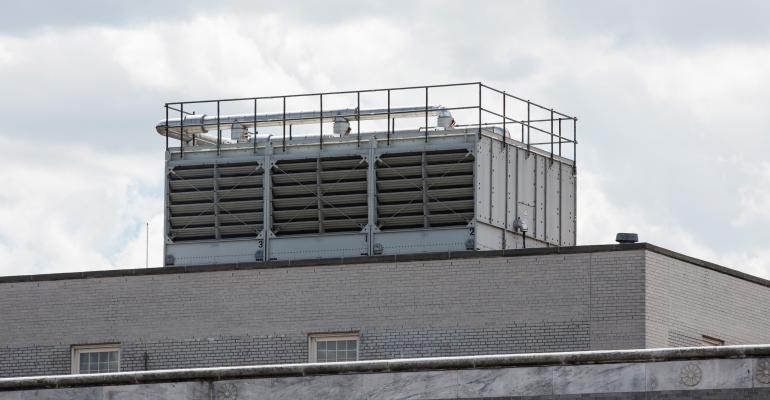In response to the largest outbreak of Legionnaire’s disease in recent history, the New York City Council recently passed legislation that requires building owners to conduct quarterly inspections of cooling towers, which have been indicated as the potential source of the outbreak in the South Bronx, where nine cooling towers have tested positive for the bacteria that has killed 12 and affected over 120 residents.
Regular inspection and maintenance of cooling towers is not just a health issue, it is essential to insure the peak operation and extend the lifespan of this critical equipment. Preventing the growth of legionella is enough reason to take care of cooling towers, but it can also help to save money in energy and equipment costs. A dirty cooling tower needs to work harder and impacts efficiency. It can also stress the equipment, leading to breakdowns.
Cooling towers, evaporative condensers and fluid coolers use a fan to move air through a recirculated water system. This allows a considerable amount of water vapor and sometimes droplets to be introduced into the surroundings, despite the presence of drift eliminators designed to limit droplet release. These towers are an ideal place for legionella to flourish due to accumulated algae, mold or bacteria mixing with the tower’s warm water. This creates a perfect environment for bacterial growth. Proper maintenance is necessary both to control bacteria growth and to prevent rust and corrosion that may inhibit effective operation.
Recommendations for proper maintenance, cleaning and disinfecting of cooling towers have been established for decades; however, very few municipalities have laws on the books mandating these measures or infrastructure in place to oversee the task of insuring compliance. Some experts who have long called for more stringent regulation of cooling towers have said the current outbreak and the city’s response have offered a chance to address a serious public health risk that is highly preventable.
 Others note that cooling towers are only one of many sources of the disease, with 10,000 to 18,000 cases reported annually, and that building owners may be unfairly singled out by enacting hasty, stringent legislation. Other sources of the disease include humidifiers, mist machines, whirlpool spas and hot springs, although none of these are likely to have caused such a concentrated outbreak in the South Bronx. Domestic hot water systems are also susceptible if water temperatures are not kept at optimal levels and recirculating systems and mixing valves are not calibrated properly. Recent news of this issue at a multifamily complex in the Bronx has heightened awareness of this building system as well.
Others note that cooling towers are only one of many sources of the disease, with 10,000 to 18,000 cases reported annually, and that building owners may be unfairly singled out by enacting hasty, stringent legislation. Other sources of the disease include humidifiers, mist machines, whirlpool spas and hot springs, although none of these are likely to have caused such a concentrated outbreak in the South Bronx. Domestic hot water systems are also susceptible if water temperatures are not kept at optimal levels and recirculating systems and mixing valves are not calibrated properly. Recent news of this issue at a multifamily complex in the Bronx has heightened awareness of this building system as well.
Under New York City’s new legislation, building owners will now have to provide annual certification that their towers have been inspected, tested, cleaned and disinfected. The legislation also requires building owners to carry out a maintenance plan and to register any cooling towers, or face penalties that vary from fines to potential prison time, depending on the severity of the transgression. New York City will be one of the first jurisdictions to impose such requirements.
The legislation affects thousands of New York City buildings, although the exact number is not known, as the city does not currently have a registry of cooling towers. The new law does raise questions about how so many inspections can be carried out so quickly (the law calls for compliance in 30 days), who is qualified to certify these inspections and how the city will enforce the requirement.
It typically takes two days to clean a cooling tower using a process that involves adding cleaning agents and sanitizers to the water circulating through the unit and then shutting it down to drain the water so that workers can scrub and pressure-wash the tower. It can take weeks to get results on the level of bacteria in water samples. The process will be time- and labor-intensive.
Fortunately, many of New York’s leading owners already have cooling tower maintenance schedules in place, recognizing that insuring that this vital equipment is kept at peak performance is both important to the public health and good business practice. From a building assessment and investment risk management standpoint, properties that don’t have such programs in place can raise red flags during the due diligence process and raise questions about overall maintenance practices that might warrant further inspection.
Whether other municipalities begin to consider similar regulations regarding cooling tower maintenance remains to be seen, but the new legislation is an important first step in preventing a highly avoidable situation in the future.
Robert J. M. Occhiogrossi, R.A., NCARB, LEED AP, is managing director ofIVI Assessment Services, a CBRE Company.

